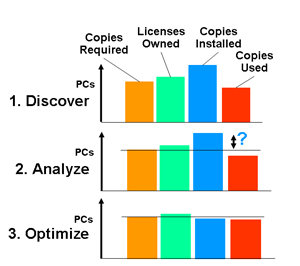ARTICLE: Driving Down Software Costs with Software Asset Optimization – Three Phase Optimization Process (Part 5/6)
 This article series has been contributed by Colin Bartram of Vector Networks.
This article series has been contributed by Colin Bartram of Vector Networks.
In this series Colin looks at how organisations can drive down software costs with proactive software management.
Driving Down Costs with Software Asset Optimization
Part 1: Extending Audit Horizons
Part 2: Software Asset Optimization Defined
Part 3: High Level Business Drivers
Part 4: Optimization’s Potential Benefits
Part 5: Three Phase Optimization Process
Part 6: Fast Track to Optimization Benefits
PART FIVE – Three Phase Optimization Process
The process of applying the four functions to the goal of Software Asset Optimization has three main classes of activity –
- Set-up and discovery
- Analysis of discrepancies and identification of priorities for action
- Optimization actions – redeploying applications, consolidating maintenance purchases, etc
Optimization Activities and Priorities
This matrix summarizes the full set of potential activities in the three stage optimization process. Each organization will decide where it wishes to deploy its resources first, depending on its goals.
IT asset management tools will be needed to fully exploit the potential of optimization, including software inventory and software usage measurement. Tools are readily available, including on a temporary basis for an investigative survey.
Optimization Factor |
Set up and Discovery |
Variance Analysis |
Optimization Action |
| Copies Installed (Inventory) | Resolve any applications not recognized by the inventory/discovery tool | Regular review of correlation of inventory with licenses owned. | Removal and redeployment of applications for compliance. |
| Copies Required (Application Policies) | Define application policies in consultation with IT and user departments. | Regular review of correlation of inventory and usage with application policies. | Regular review and update of application policies to define desktop IT needs. |
| Copies Used
(Software Metering) |
Low initial setup task, Low ongoing maintenance. |
Regular review to identify unused copies of software. | Regular review to identify wasted installations that can be redeployed or where training is required to enable use. |
| Licenses Owned (License Recording) | High initial data input Steady ongoing update. |
Regular review of correlation of inventory with licenses owned. | Ensure licenses are correctly recorded. |
About the Author
Colin Bartram is VP Technology with Vector Networks Technology Group. He has been involved in the evolution of IT asset management since its inception in the 1980s, holding positions primarily in marketing and product management. Further information regarding Vector Networks can be found here.
Can’t find what you’re looking for?
More from ITAM News & Analysis
-
Software Vendor Insights: What do the numbers tell us about the opportunities for ITAM negotiations?
What software vendor insights can be gained from the latest financial results from Amazon, Google, Broadcom, Salesforce, IBM and SAP? An important part of ITAM is paying close attention to the health of the companies we ... -
Flexera is first SAM tool vendor verified for Oracle E-Business Suite applications
Flexera has announced that it has been verified as the first software asset management (SAM) tool vendor for Oracle E-Business Suite applications. Almost anyone with an Oracle estate will be familiar with the company’s License Management ... -
ITAMantics - March 2024
Welcome to the March 2024 edition of ITAMantics, where George, Rich and Ryan discuss the month’s ITAM news. Up for discussion this month are. Listen to the full ITAMantics podcast above or queue it up from ...
